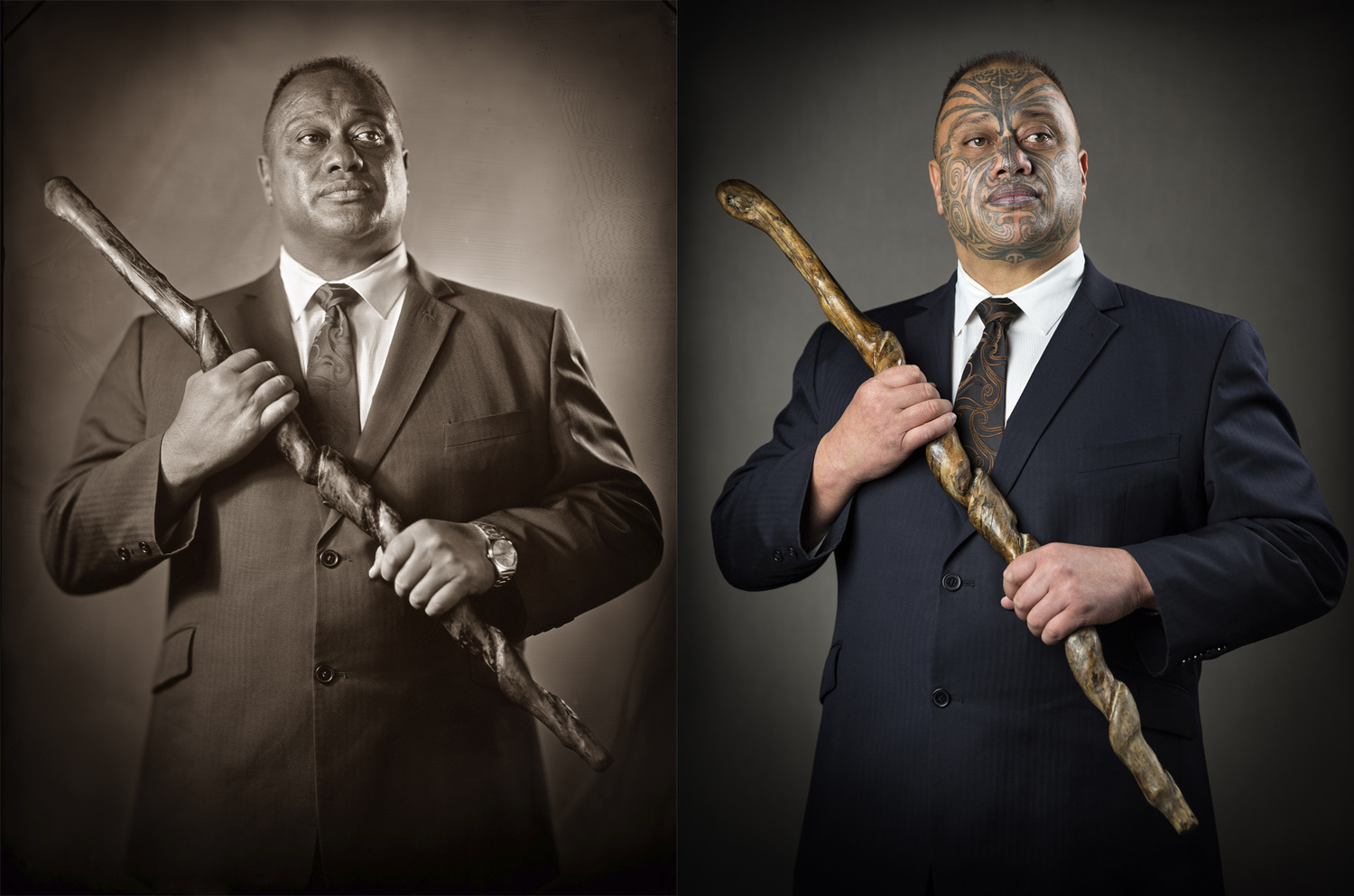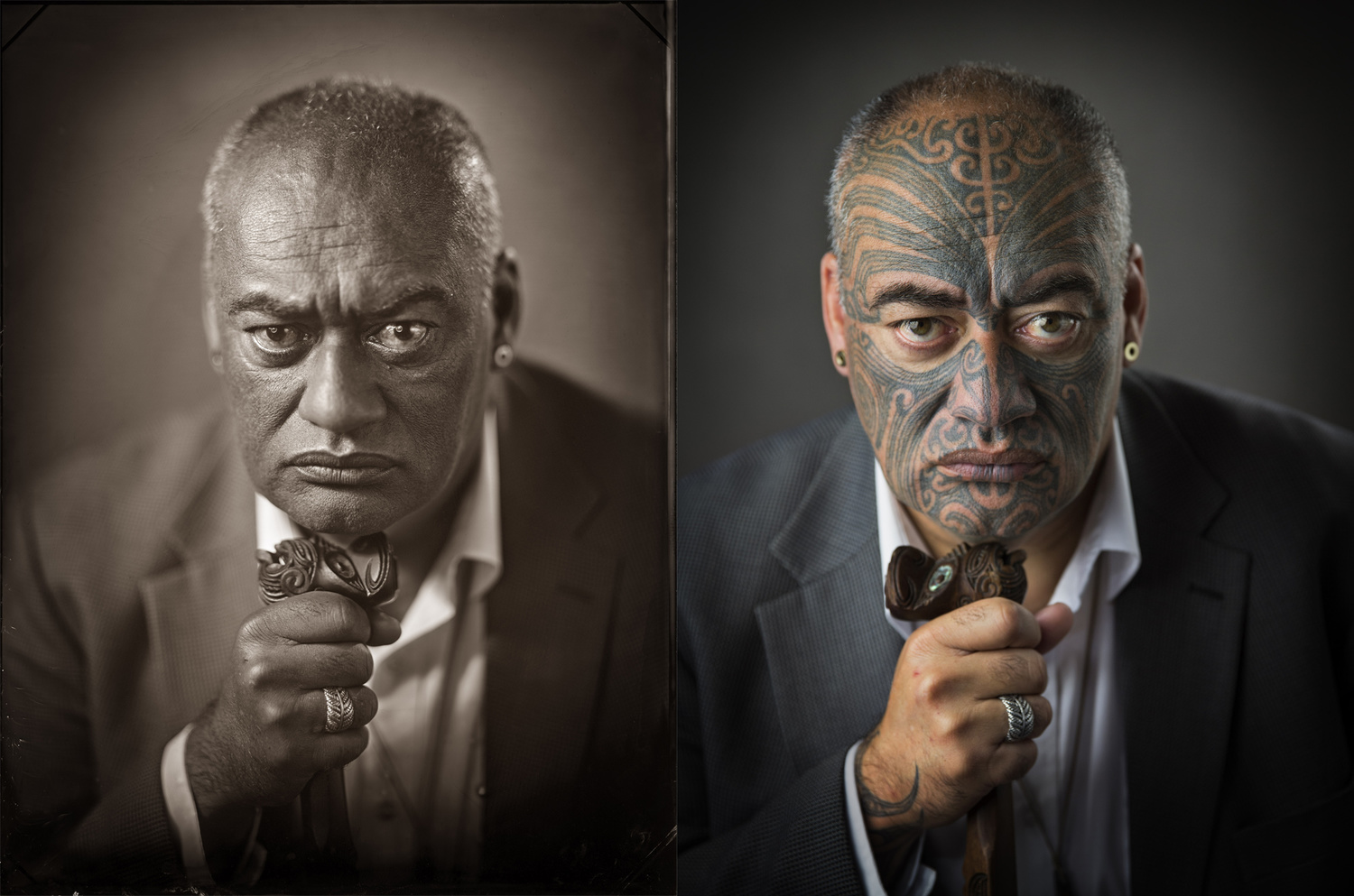A photographer has found an amazingly cool way to capture and honor the art of facial tattoos from the indigenous New Zealand culture the Māori. Using the wet collodion process, the subjects appear to have their ink magically removed in portraits hung next to modern digital photos creating a surreal before and after effect.
The permanent face designs are called tā moko. There is a very rich and cherished history of this tradition. In Māori culture, it is believed everyone has a tā moko under the skin, just waiting to be revealed to the world. Members of the society without the markings were considered of a lesser social status. Receiving the moko was an important milestone in becoming an adult. It was also desirable because they were believed to make oneself more attractive to the opposite sex.
Traditionally the designs were actually chiseled into the skin using a tool called a uhi, as opposed to being punctured like a modern ink based tattoo gun. This means although the pigment of the ink appears invisible in the historical wet collodion photos, you can still see the texture and grooves made by the application tools if you look closely enough. Most of the Māori will opt for the convenience and effectiveness of modern day tattoo tools these days so the disappearance is drastic.
Photojournalist Michael Bradley learned of the cultural tradition and how it was all but lost after European colonization in the 1850s. The only photographic records showed no tattoos except for those added beforehand with makeup or after by drawing on the photo itself with pen or pencil. He became fascinated with the way the fading of the tattoos in the wet collodion prints mirrored the traditions prominence in the culture. As time went on, fewer and fewer Māori were wearing the markings as they tried to fit into the new society around them.
Luckily, the act of getting the tā moko made a comeback and the art is experiencing a revitalization. Bradley sympathized with the struggle to preserve an important element of Māori culture and found a wonderful trick to display it in a unique way. His project is called "Puaki," which means "to come forth, show itself, open out, emerge, reveal, to give testimony."
Try out this slider below to reveal the designs hidden by the wet collodion prints. Please note, they are completely different shots and not a Photoshop effect so the subject is not in the exact same position or angle.
Bradley was fascinated by the fact that the analog photographic process, widely thought of as genuine and authentic, showed a twisted version of reality.
This exhibition forms an important social documentary of the people who choose to proudly wear tā moko today embracing their history and showcasing one of the many endangered traditions still holding strong in today's modern society. Twenty-three participants have their portraits shown side by side. Prints shot with an 85-year-old wet collodion camera were displayed on the left, and a photo captured on a modern camera on the right. Being a trained photojournalist, Bradley felt it was important for the portraits to be as authentic as possible. For this reason, each subject was able to select their own outfit and pose. Bradley even went on to record videos speaking about behind each individual's story and meaning behind their tā moko.
The exhibition is hosted at the Kōngahu Museum of Waitangi in the Bay of Islands, New Zealand. It started on May 26, 2018 and runs until September 2, 2018. Below is the video from the opening reception. Many of the subjects from the photos we there for the event and appear grateful to Bradley paying homage and respect to their cherished tradition.
As is often the case with personal projects like this, I found myself very impressed with the story behind the photos. Bradley took something that moved him and went head first into finding a way to share it with the world. This is certainly a great example of how you get from taking beautiful photos, to having people stop what they are doing and look at what you have created.
Bradley's work can be seen on his website, Facebook, Instagram, and Twitter.
All photos used with permission by Michael Bradley.












That's actually pretty nifty. I'm not really all that familiar with wet plate collodion so could anyone explain why the tattoos don't show up in the process?
I'm not familiar with wet plate photography either, but my guess is that the chemicals react more to the IR or UV light than visible light. There for we are seeing more of those spectrums then what we would with RGB sensors. Everything looks different when filtering out specific ave lengths.
For example:
https://youtu.be/FyH-b_LDlSY
Collodion only has a spectral response to blue light. Wavelengths longer than 600nm (red and orange colors) are largely go undetected during the exposure process; that is, they appear as black. My assumption is the ink pigment used for the tattoos is a deep red color, so it becomes undetectable against the darker complexion of native Maori.
Good to know. My next guess was that whatever wavelength that the collodion reacted to didn't penetrate the skin where the tattoos are. Bouncing off the surface, straight to the lens.
The ink is initially black, before turning green as it oxidises. Much like contemporary tattoo.
Check out: https://www.maoritelevision.com/news/regional/historic-exhibition-lindau...
Lindauer is famous for his contemporary portraits of Maori.
VERY VERY COOL! I must add a *tiny* bit of correction to something though: as a heavily tattooed person myself and knowing many artists and tattooed people, lets just change the wording from "tattoo gun" to "tattoo machine". It's not a gun and many artists would tell you that :-) . Btw I'm not trying to be facetious at all it's a common misconception that I would like to see changed. So my friends, tattoo machine, not a tattoo gun. And a very very very cool photo project. :-)
Thank you, Jeremy Segal. I just learned something new.
Glad you liked the article!
This is a very cool exhibition - I'd love it if he took the exhibit to Auckland or Wellington.
I too would love it to travel. Something that I am currently working on. Both here in NZ and abroad.
I'm not sure how erasing the tattoos is a way to honor them, but if that's what you want to do, there's no need to resort to an archaic chemical process. You can achieve the same effect in Photoshop in a minute or two:
The idea is that the past (colonisation) tried to erase their culture, but it can make a comeback
Hey Joe, thanks for taking to time to view my work and yes I would have save a lot of time, effort and money by doing this in photoshop. But that is exactly the opposite of what I was trying to achieve with this project.
I was honouring the resurgence of the tā moko since the 1850's until now NOT by erasing it but showing the two images side by side as one piece of art and to celebrate the resurgence and reclaiming of this art form. Wont go into all the detail here but there is some more information on these links if you would like to read a little more about the work.
https://www.nzherald.co.nz/lifestyle/news/article.cfm?c_id=6&objectid=12...
https://www.facebook.com/TheProjectNZ/videos/1237363709733613/UzpfSTEyMz...
http://www.maoritelevision.com/news/national/wearing-moko-not-my-right--...
Very cool, but...I'm very disturbed by this side-by-side pairing: https://cdn.fstoppers.com/styles/full/s3/media/2018/06/29/wet_collodion_...
I would have expected the colloidal print to have removed the watch from the subject's wrist, which would be revealed (along with the tā moko) in the modern print. This side-by-side has the artifacts reversed.
Or, perhaps the real story is that historically a highly honored chief might have had a wrist watch, whereas modern-day Māori uses their iPhones (not pictured) to tell time. In which case, that's a very subtle joke!
You are only the second person to notice this. It was asked of me why and how the modern digital camera made the watch disappear. But I do hope you are not too disturbed.
Magic :D